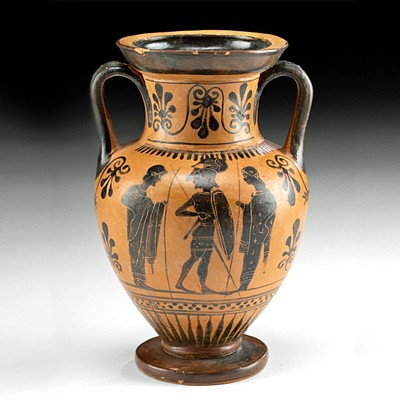Roman Limestone Cippus w/ Medical Gods & Inscription
Lot 59
About Seller
Artemis Fine Arts
686 S Taylor Ave, Ste 106
Louisville, CO 80027
United States
Selling antiquities, ancient and ethnographic art online since 1993, Artemis Gallery specializes in Classical Antiquities (Egyptian, Greek, Roman, Near Eastern), Asian, Pre-Columbian, African / Tribal / Oceanographic art. Our extensive inventory includes pottery, stone, metal, wood, glass and textil...Read more
Estimate:
$3,600 - $5,400
Absentee vs Live bid
Two ways to bid:
- Leave a max absentee bid and the platform will bid on your behalf up to your maximum bid during the live auction.
- Bid live during the auction and your bids will be submitted real-time to the auctioneer.
Bid Increments
| Price | Bid Increment |
|---|---|
| $0 | $25 |
| $300 | $50 |
| $1,000 | $100 |
| $2,000 | $250 |
| $5,000 | $500 |
| $10,000 | $1,000 |
| $20,000 | $2,500 |
| $50,000 | $5,000 |
| $100,000 | $10,000 |
| $200,000 | $20,000 |
About Auction
By Artemis Fine Arts
Mar 9, 2023
Set Reminder
2023-03-09 10:00:00
2023-03-09 10:00:00
America/New_York
Bidsquare
Bidsquare : Exceptional Ancient, Ethnographic, & Fine Art
https://www.bidsquare.com/auctions/artemis-gallery/exceptional-ancient-ethnographic-fine-art-12354
Artemis Fine Arts info@artemisfinearts.com
Artemis Fine Arts info@artemisfinearts.com
- Lot Description
**First Time At Auction**
Roman, Republican period, ca. 2nd to 1st century BCE. An important travertine limestone relief cippus or marker featuring the 3 gods of healing: Hygeia, the goddess of health, next to her brother Telesphorus, the child-god of recovery from illness, with their father, Asclepius the god of medicine, all standing in an archway as though passing through the threshold of the divine and mortal worlds. In contrapposto at the right, the bearded Asclepius wears a simple himation with a bare chest and grasps his serpent-entwined staff known as the asklepian. Hygeia, draped in a voluminous chiton, feeds a large fruit to a snake that wraps around her arms, while the hooded Telesphorus stands between them. Liberal remains of a Latin or Greek inscription are featured above and below the figures. A fabulous example of ancient medical iconography! Size: 8" W x 10.2" H (20.3 cm x 25.9 cm)
In Greek and Roman mythology, Hygeia was one of the children of Asklepios and Epione, and was known as the goddess of health, hygiene, and cleanliness. While her father was associated with healing, Hygeia was associated with preventing illness and maintaining good health. Her name, of course, is the source for what we know of as hygiene. The son of Asclepius and sister of Hygeia, Telephorus was a demi-god of convalescence, who "brought to fulfillment" recuperation from illness or injury. He frequently accompanied his sister, Hygeia, as seen here. He was a dwarf whose head was always covered with a cowl hood or cap. He symbolized recovery from illness, as his name means "the accomplisher" or "bringer of completion" in Greek. Representations of him are found mainly in Anatolia and along the Danube. Telesphorus is assumed to have been a Celtic god in origin, where he would have become associated with the Greek god of medicine, Asclepius, perhaps in Pergamon - an Asclepian cult center - and spread again to the West due to the rise of the Roman Empire, in particular during the 2nd century CE, from the reign of Hadrian, after Epidaurus, the main center of the cult of Asclepius, had adopted him.
Prior to the 2nd century, Romans cremated their dead; around that time, inspired by the Greek and Etruscan practice of using sarcophagi, they began to place their dead in sarcophagi. This trend spread rapidly throughout the Roman Empire. In the western part of the Empire, sarcophagi were placed inside a mausoleum against a wall or in a niche, so the only decorated panels were on the front and the short sides. This stele probably came from the grave of a high-status Roman citizen.
PLEASE NOTE: Due to recent increases of shipments being seized by Australian & German customs (even for items with pre-UNESCO provenance), we will no longer ship most antiquities and ancient Chinese art to Australia & Germany. For categories of items that are acceptable to ship to Australia or Germany, please contact us directly or work with your local customs brokerage firm.
Provenance: private New York, New York, USA collection; ex-Andrew Sumi collection, purportedly acquired from a French collection in 1994
All items legal to buy/sell under U.S. Statute covering cultural patrimony Code 2600, CHAPTER 14, and are guaranteed to be as described or your money back.
A Certificate of Authenticity will accompany all winning bids.
We ship worldwide and handle all shipping in-house for your convenience.
#176517Nicks, chips, and abrasions, commensurate with age, but otherwise intact with liberal remains of inscription and detail.Condition
- Shipping Info
-
All shipping is handled in-house for your convenience. Your invoice from Artemis Gallery will include shipping calculation instructions. If in doubt, please inquire BEFORE bidding for estimated shipping costs for individual items.
-
- Buyer's Premium



 EUR
EUR CAD
CAD AUD
AUD GBP
GBP MXN
MXN HKD
HKD CNY
CNY MYR
MYR SEK
SEK SGD
SGD CHF
CHF THB
THB













